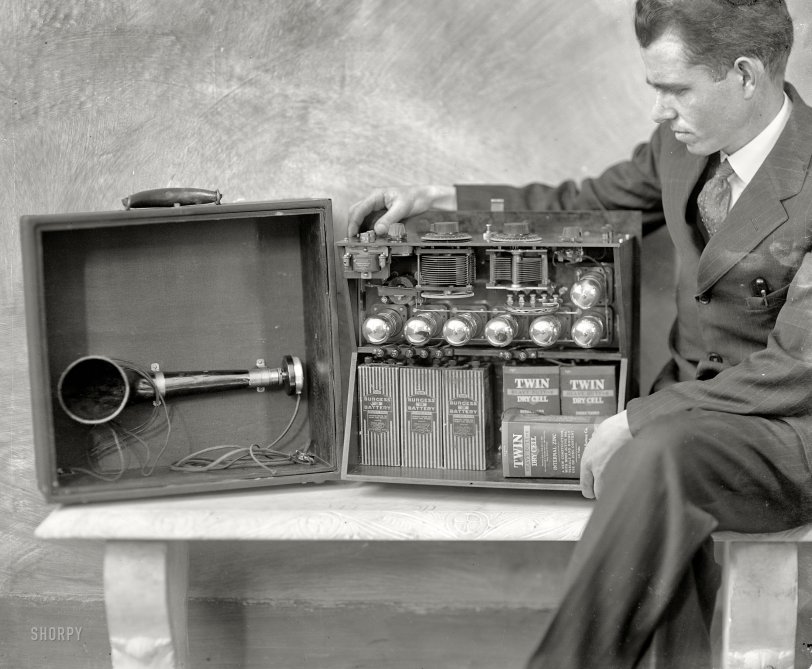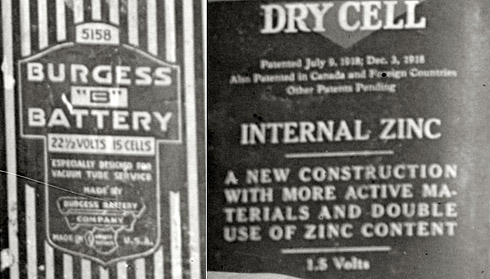


Framed or unframed, desk size to sofa size, printed by us in Arizona and Alabama since 2007. Explore now.
Shorpy is funded by you. Patreon contributors get an ad-free experience.
Learn more.

- Lofty addition
- In 1912
- Keenan Building
- Six years old
- Taken from the P.J. McArdle Roadway?
- It stood only 47 years
- Three track mind
- Incline to the right
- Reach for the sky, 1912 style
- No clean sweep
- Same Job Title, Same Face
- Sadly Lost
- Beautiful ...
- Where you get your kicks
- Aim High
- Pueblo Revival sisters
- Pueblo Neoclassicism
- Milk Man
- Regional dialect.
- Spielberg's inspiration
- Great Photo
- Loaf Story
- Do you still have the Rakes category?
- Could almost be a scene from the 1957 movie 'Hell Drivers'
- The Wages of Fear.
- Conspicuous by their absence
- Got Milk?
- All that aluminum
- No lefties
- Smoke 'em if you've got 'em
Print Emporium
Suitcase Wireless: 1924

Washington, D.C., circa 1924. "Brent Daniel, formerly of the Radio Laboratory of the Bureau of Standards at Washington, with the first portable Super-Heterodyne, his own design. The seven vacuum tubes, batteries, loop antenna, loudspeaker and other necessary units are completely self-contained in the carrying case. He has been able to hear Pacific Coast stations from this outfit." View full size.
Not the only portable
I happen to be the owner of a RCA Radiola AR-812, which is considered the first commercially produced superhet, and, which was considered a portable radio. Production began in 1924, and the radio sold for the bargain price of $220! It's an enormous thing, one foot high by one foot deep by three feet wide, with a mahogany veneer. I have a wonderful ad somewhere showing two guys camping, with fish in the pan, "listening to the big game". The tubes are encased in beeswax to protect them during transport. This feller's is a homebrew model. To understand the importance of the superhetrodyne technology, one must realize that there were several competing systems vying for dominance when the superhet came out. Today, if you have a radio, it's a superhet, period.
Many of the facets of radio we take as given today were not yet common when these radios were being built. For example, the mHz system was not yet adapted, so every single knob on the radio scales from 0-100. Volume knobs, tuning knobs, everything. Gotta love it.
[Spelling note: heterodyne, not "hetrodyne." - Dave]

Zenith Transoceanic
The largest radio I sold was the Zenith Transoceanic Radio. Zenith produced this shortwave radio that could be powered by AC or batteries . It was first produced in 1942 and continued to be made until 1981. In 1960 it sold with the batteries for about $160, figuring the average U.S. wage at the time at about $4000, it cost about 2 weeks pay. It weighed in excess of 25 lbs.

Dry Cell Batteries
Zinc-carbon chemistry gives 1.5 volts per cell, so all batteries made up from them in series will be multiples of that. The "A" battery was for the filaments, "B" for the high plate voltage (often 90V), and "C" for the grid circuits of the vacuum tubes (often 67.5V, so three of those 22.5 bats in this - four would give the 90V). The UV-199s (triodes) in it have 3V filaments, drawing 0.06 amp each. Larger current capacity is achieved by using cell electrodes with more surface area (so larger and heavier cells) or by connecting smaller cells/bats in parallel. On those large "Twin Cells" on the right their terminals are marked "carbon +" and "zinc -". Burgess has an interesting history with its distinctive "zebra striped" product.
Ultimate geek
He's even got his pocket pen protector! This must have been very advanced for 1924.
The superheterodyne receiver
The superheterodyne receiver and FM radio were both invented by Edwin Armstrong, generally acknowledged the greatest American radio engineer. A Signal Corps officer in WWI, he gave his patents to the US government during both WWI and WWII. FM radio contributed to Allied victory in WWII since it provided communications when AM did not. Armstrong lost a years-long patent fight with RCA and committed suicide in 1954. His wife continued the fight and eventually won the FM patents from RCA. Armstrong's life is documented in the book and Ken Burns' film "Empire of the Air".
Superheterodyne
The big word "superheterodyne" means that this radio was quite advanced over the common tuned radio frequency (TRF) radio of the day. The fact that it has seven tubes and only two tuning knobs is unique among 1920s radios. Later, the two tuning knobs were put on a common shaft, allowing the single knob we're used to.
The trick used in this model is that it converts the station's frequency to a lower intermediate frequency that's the same no matter which station you're listening to, and amplifies the weak signal using an amplifier that's factory-tuned to that one frequency, instead of requiring the listener to tune several amplifier stages to the station's frequency. Hence the need for fewer tuning knobs.
By 1935, after the patent mess got sorted out, this type of radio completely replaced the TRF radio that Atwater Kent made a fortune from. It later became known as the All-American five tube radio, after the bean counters whittled every last penny from the design in the late thirties.
Complete in Itself
Washington Post, July 15, 1923.Make Successful Test of
Portable Suitcase Radio SetLocal Enthusiasts Get Clear Reception
With Type Built by Brent DanielVarious types of portable radio receiving sets have appeared from time to time in the last few months. While taking different forms, all the sets require either an external coil aerial or overhead antenna when in use, thus limiting their use to stationary installations or specially equipped conveyances.
A Washington manufacturer recently has standardized a design of portable receiving set which is complete in itself. The entire outfit, including all the batteries and coil aerial, is contained in a medium-sized light-weight suitcase.
This portable receiver is ready for important use at any time by merely closing the switch which lights the filaments of the six UV199 vacuum tubes used in the radio audio amplifier receiver. This amplifier employs three stages of DX-12 radio frequency transformers, detector and two audio stages. The same type instrument in nonportable form has been used repeatedly in the reception of transcontinental radiophone signals by employing a three-foot square coil aerial.
The builder of this portable set, Brent Daniel, recently made a series of tests to determine the practicability of its use in an automobile in motion, and in general outdoor reception. WCAP, the Chesapeake and Potomac Telephone station, was tuned in when the set was located on the fourth floor of an office building. Leaving the set in operation with the musical program from the broadcasting station coming in clear and loud, the set was carried downstairs and placed in an automobile without once interrupting the reception. When the car started off, the ignition spark was quite audible with the set placed near the bed of the machine, however, by placing it in different positions, the spark was not audible. …
These tests, and the reception accomplished later with this portable set demonstrated its scope of usefulness in the hands of the auto-tourist or vacationist. With a high-class broadcasting station within a few hundred miles range, the user of such a set is assured of entertainment, regardless of his location. …
The outstanding feature of this portable receiver is that when the summer season is over and a radio set is wanted for the home during the winter, it is only necessary to remove the amplifier receiver unit from the portable case and place it in the regular mahogany case which is furnished for indoor use.
At least we can figure it out!
Unlike an iPod, at least the components are somewhat easy to understand. Wonder what he would think of an iPod?
Reflections
I love it when one of these old photos contains a reflective surface that provides a bit of unintentional insight into the background. In this case, each of the silvery tubes tells a slightly different story - depending on which one you look at, you can see the subject's hands, legs, and feet, the camera and a bit of the photographer, the large window that runs the length of the studio, some sort of lamp that's projecting a halo of light onto the ceiling, various bits of furniture and shelving, and if I'm not mistaken, part of the (adjoining?) building outside the window.

And thirty years later.
It came down to this size. This is the first commercial transistor radio sold in 1954 by Regency. I remember listening to many a Giants game one those transistors. I wasn't around for the one in the main photo.

Portable, all right
If you have a dolly!
The latest technology...
"Transistors Under Glass"
Batteries
The batteries on the right power the low voltage high current filaments, probably 6v in parallel; the batteries on the left supply probably 48v each in series for a jolting 144 volts for plate current. Keep your fingers out.
Batteries were the problem; they're heavy, expensive and costly to replace, which they are often.
If you can't pick up anything, you can at least keep yourself warm from the heat it throws off.
[The 15-cell batteries on the left are 22.5 volts each, or 1.5V per cell. "Heavy Duty 6" on the right are labeled 1.5 volts (per cell, I guess). - Dave]

The ultimate in portability
It's the size of a Breadbox and only weighs fifty pounds!
You just know he was thinking that they'll never get any smaller than this!
























On Shorpy:
Today’s Top 5